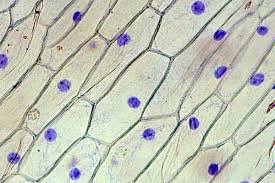Author's note; This is a PHEOC on the affects of different mixtures on plant cells.
- Microscope
- Slides/slide covers
- Onion
- Tweezers
- Beakers
- Pipette
- Water
- Blue Dye
- Hydrochloric acid
- Sugar
- Cornstarch
- Baby Powder
- Baking powder
- Baking Soda
- Salt
Problem: What affects will
different combinations of substances and blue dye have on the cells of an
onion?
Hypothesis: I think
that the thicker the substance, the smaller the cell membrane will get. I
think this will happen due to previous research on the traveling of water
molecules through the membrane. While the water molecules freely float in and
out of the cell, the bigger molecules will not be able to enter, staying on
the outside of the membrane.
Experimental
Design:
Materials:
Variables:
CV: The layer of
the onion used, the slides and slide covers used.
IV: The mixtures
used on the piece of onion.
DV: The effect of
the mixture on the onion.
Procedure:
We will
consistently draw the same part of the onion, the epidermis, a layer that is
exactly one cell in thickness. We will then place the epidermis on a slide and
add around two or three drops of the mixture, and finally place the slide
cover on top, attempting to eliminate all air bubbles. The onion will then
sit, reacting to the mixture, while at least two more are made with the same
mix to produce an accurate observation. We will then collect information about
the reactions and provide a conclusion.
Following the
application of simple combinations such as sugar or salt water, we observed
the membrane shrinking into the cell, whereas the cell wall remained the same.
With thicker substances with larger molecules we didn't see results we were
expecting. Although we could see the nucleus, the cell wall and membrane
seemed unchanged.
Conclusion and
Analysis:
Kendall and I
hypothesized that because of the small size of the sugar and salt molecules,
they were allowed to flow freely in and out of the membrane along with the
water. We believe the process of diffusion evened the concentrations out,
causing the cell to lose water, and shape. The appearance of the nucleus threw
us off for awhile until we realized that it was simply the blue dye that had
soaked into it, making it visible. We concluded that we did not have a high
enough concentration of blue dye in the other mixtures. Although there were
several variables that weren't consistent and our overall observation did not
provide one conclusion, we did see some things we were expecting to happen to
the cell and our previous research helped a lot with the understanding of the
experiment.

No comments:
Post a Comment